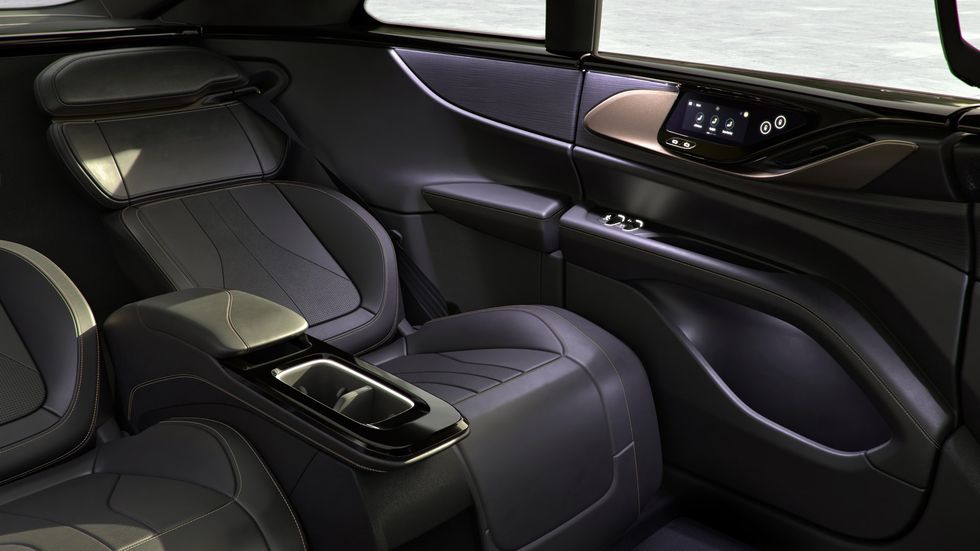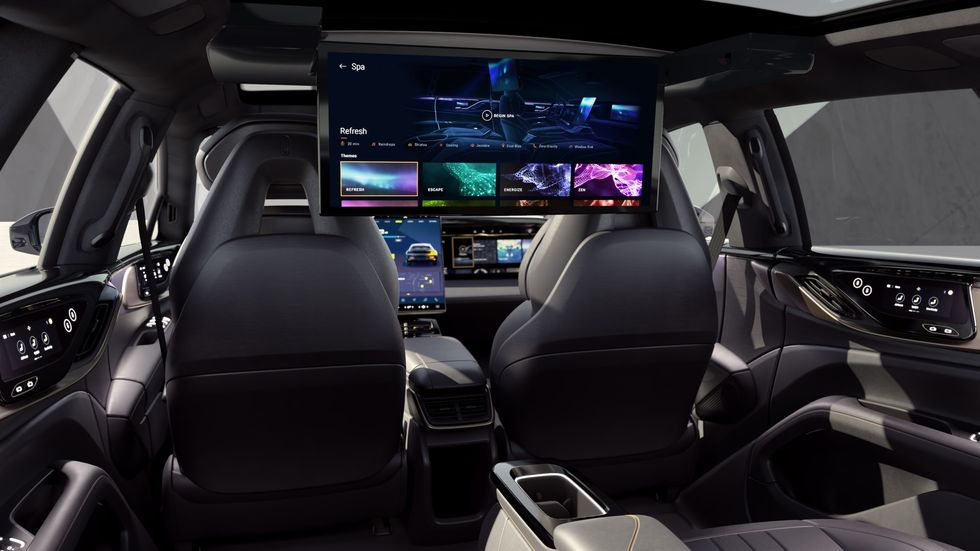- Faraday Future delivers the first unit of the Ultimate AI TechLuxury FF 91 2.0 Futurist Alliance, featuring a 142-kWh battery, with three motors producing 1050 hp and 1458 lb-ft of torque.
- The most expensive of the planned model range, the Ultimate AI TechLuxury boasts a 0-to-60-mph launch of 2.27 seconds, in addition to extensive tech inside, which carries an annual fee of $14,900.
- The EV startup plans to guarantee a resale value of at least 60% on this $309,000 version of the vehicle after three years.
Faraday Future has begun shipping the priciest and most futuristic version of its debut model, dubbed Ultimate AI TechLuxury FF 91 2.0 Futurist Alliance, in the process also setting a record for EV name length.
Indeed, so much time has passed from the first appearance of the FF 91 as a concept car back in 2017 and the present day, that the long crossover/MPV has gained a prefix denoting artificial intelligence—and is now called version 2.0.
Whatever happened to version 1.0, some of you are probably wondering, and did they even exist as units sold to customers?
“Faraday Future has completed a comprehensive upgrade and iteration, transitioning from the 1.0 era to the 2.0 era since the introduction of the FF 91 six years ago,” the EV startup explains.
If you’ve been following Faraday’s progress, you already know that version 1.0 did not enter series production.
What does one get for having to answer “Ultimate AI TechLuxury FF 91 2.0 Futurist Alliance” to people in the Costco parking lot who ask what their electric MPV is called?
Three motors producing a combined 1050 hp and 1458 lb-ft of torque, for starters, along with a 142-kWh battery giving the EV an EPA-rated range of 381 miles. The FF 91 2.0 Futurist Alliance also boasts a 0-to-60-mph time of 2.27 seconds, which will easily make it the fastest MPV in the same parking lot and beyond.
Buyers will also get “11+ displays” inside, which averages out to almost three screens per passenger including the driver. This includes a massive fold-down 27-inch screen for the benefit of rear seat passengers, perhaps shedding light on the actual customer base of the FF 91 in China, where the model will be offered.
Along with the EV itself, Faraday Future rolled out something called AI-Powered 6×4 aiHyper Technology 2.0 Architecture technology structure, offered for an annual subscription of $14,900.
Described as a “mobile ecosystem product,” this long sequence of futuristic-sounding names is a technology package that includes Hyper Multi-Vectoring torque vectoring system, a Magic All-In-One suspension control system, and something Faraday calls the 3rd aiSpace System, which includes three 5G modems for enhanced connectivity, mostly for the benefit of rear-seat passengers.
“FF 91 2.0 creates a mobility work scenario by moving the meeting room and live broadcast studio to the car and delivering the ultimate AI mobility lifestyle,” is how Faraday Future explains the purpose of this many modems and screens.
Now that it’s finally here, does this version of the FF91 seem especially futuristic?
That’s a tougher question, as many of the specs have been surpassed since our first glimpse of the FF 91 in 2017; it isn’t the most powerful, fastest, or longest-ranged EV on the market.
However, it probably would hold all of these titles in the electric luxury MPV segment, or even in the crossover segment, as its main competitors in the performance category are mostly sedans.
The FF91 appears to be a vision of the future where futurism is measured by the number of screens inside, along with AI assistants, video-conferencing capabilities, and passenger pampering tech.
Needless to say, a $309,000 EV sounds like something that will depreciate rather quickly, especially with the pace of EV debuts.
To mitigate some of the eye-watering depreciation currently seen in the EV sphere, Faraday Future is planning to offer something rather unusual.
“To always ensure the ultimate performance and the most updated product and technology experience for the FF 91 2.0 Futurist Alliance users, FF guarantees a resale value of at least 60% on the FF 91 2.0 Futurist Alliance MSRP after 3 years, as part of the ‘Ultimate AI TechLuxury Eternity Plan,'” the company says. “This plan will be revisited at the end of 2023.”
With 300 units of the Futurist Alliance planned, the EV startup appears poised to perfectly meet the demand for EVs with this much tech inside positioned firmly in the mid six figures. Its most natural segment appears to be the luxury MPV segment in China—a popular niche for two decades now, with emphasis placed on legroom and seat massagers.
But it’s not a traditional limo, and it doesn’t want to be one.
For instance, a partition for the driver is not one of the options, even though the FF91 will presumably compete with some stretched SUVs that do feature a partition. As a mobile conference room, the FF 91 also comes up short, as it doesn’t feature a middle row of rear-facing seats, unlike some recent Mercedes-Maybach limousines that were also in mid-six figure territory.
The picture that inevitably emerges is that this is a vehicle aimed first and foremost at the luxury MPV segment in China, with most competitors in that market positioned well south of the FF 91 in price.
What sort of niche the FF91 will be able to carve out for itself stateside remains to be seen, but it looks enough like a crossover or SUV to interest those who have $309,000 to spend on an EV they will drive themselves.
Will there be a significant market stateside for EVs priced north of the $300,000 mark, or is this category rather narrow? Let us know your thoughts.

Jay Ramey grew up around very strange European cars, and instead of seeking out something reliable and comfortable for his own personal use he has been drawn to the more adventurous side of the dependability spectrum. Despite being followed around by French cars for the past decade, he has somehow been able to avoid Citroën ownership, judging them too commonplace, and is currently looking at cars from the former Czechoslovakia. Jay has been with Autoweek since 2013.
Read the full article here




